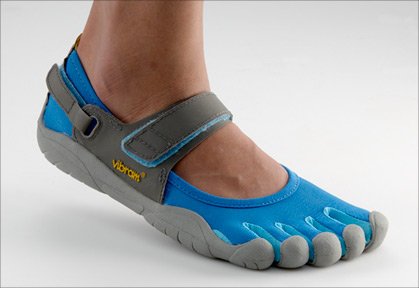Vibram, the footwear company that gave Five Fingers counterfeiters the boot
Tony Post, the chief executive of Vibram USA and former marathon runner, introduced the minimalist Five Fingers running shoe in 2007.
The footwear, which Tony Post describes as “ballet shoes with toes”, entered the market just as the so-called “barefoot” running craze took off in the US.
What started as a way to showcase the company’s design skills quickly ballooned into a multi-million dollar business.
Its revenues jumped from $400,000 in 2007 to $90 million last year, and Vibram struggled at first to keep up with demand.
It was an entrepreneur’s dream – and a counterfeiter’s.
During the summer of 2010 a package arrived at Vibram’s cosy offices, stationed in a former flannel mill in Concord, Massachusetts.
Inside were a pair of torn-up Five Fingers shoes and a complaint from a customer who said that the shoes fell apart easily.
Tony Post recalls that the shoes “looked like one of our products – it had our trademark on it – but it was made of different materials”.
When Tony Post asked the customer where they got the shoes, they named a website he hadn’t heard of.
When he looked it up, he saw that while the website included images from Vibram and even listed Vibram’s Concord address, something was wrong.
All of a sudden, Tony Post says he realized: “Oh my God, this is counterfeit product.”
Within months, his office had received more than 1,000 returned pairs. The shoes all looked similar to the original – with rubber soles and vinyl tops, and the distinctive colorful, reptilian look.
But Tony Post and his team of employees – almost all of who wear the shoes around the office – could spot the differences. They saw that the stitching between the toes was sloppy, and that the colors, while similar, were never exact duplicates of the models Vibram manufactured.
They realized that the company’s failure to keep up with demand had given counterfeiters an opportunity to move into the market.

Tony Post, the chief executive of Vibram USA and former marathon runner, introduced the minimalist Five Fingers running shoe in 2007
By the autumn of 2010, more than half of the Google search results for Five Fingers led to counterfeit sites, according to BirthdayShoes.com, a fan website.
More than $178 million worth of counterfeit goods were seized at US borders last year, according to the country’s Department of Homeland Security.
Over the past decade, the most often item seized has been footwear, with more than two-thirds coming from China.
“If bags were the thing in the ’90s, shoes are the thing in the new millennium,” says Susan Scafidi, the director of the Fashion Law Institute at Fordham University.
The growth in confiscated footwear has mirrored the growth in online sales, which has made it more difficult for authorities to track counterfeit products.
“Mail is particularly challenging because we don’t have the same information that we would have on ocean container loads of shipments,” says Therese Randazzo, director of Intellectual Property Rights Policy & Programs Division at US Customs and Border Protection, a division of Homeland Security.
This is why the agency has stepped up enforcement at areas other than the traditional ports of entry. Since 2007, there has been an 84% increase in the amount of product seized from mail centres.
Vibram’s Tony Post initially tried to go to Congress to ask for help, and even hired private investigators to take photos of the factories making the shoes.
However, he quickly realized that “Congress doesn’t work at the speed of business”, and that shutting down one counterfeit factory just led to another opening up.
Ultimately the most helpful step for Vibram was to make customers aware of the counterfeit goods.
It was a risky move, according to Susan Scafidi, who says that a company associating its name – however tangentially – with counterfeit goods could damage its brand.
Tony Post says he didn’t have a choice: “We knew if we didn’t react quickly enough, they [the counterfeits] were only going to get better… so we needed to be sure to put them in their place quickly.”
Vibram offered vouchers to customers who had unwittingly bought fake Five Fingers, so that they could buy the real product at cost price.
The company also put up a page on its website alerting customers, enlisted the help of bloggers and asked fans of its Facebook page to get the word out.
Within a year, the deluge of complaints from customers who had bought fake products slowed to a trickle.
“Candidly, you have to realize that intellectual property only gets you so far,” says Tony Post
“At the end of the day it’s really about your relationship with the consumer.”
Vibram seems to be out of the woods – but not everyone is as lucky.
Steve Behling lost his ski- and snowboard-binding business Kobe International Trading Company in 2002 to Chinese counterfeiters, who he says flooded the market with knock-offs of his proprietary designs.
“They basically drove me out of business and anybody else that was in that type of business,” he says.
“They ruined a whole industry.”
By most measures, the counterfeiting industry is growing.
A report published last year by the business group the International Chamber of Commerce estimated that from 2008 to 2015, the amount of counterfeit goods is expected to increase by more than two-fold.
Dan Harris, a lawyer with Harris & Moore and author of the popular China Law Blog, says that while American companies have got smarter about protecting their products, there is still one golden rule.
“The key is if you don’t register your intellectual property – your trademark, your copyright, your patent – you have pretty much no chance,” says Dan Harris.
But, he adds, focusing on how to protect your business can drive you crazy – and at the end of the day: “Sometimes you have to ignore it and focus on making money.”

